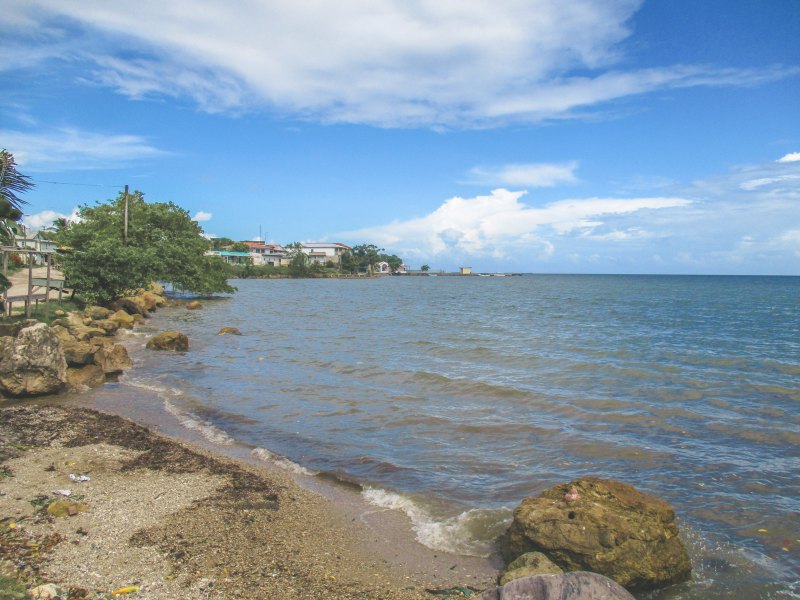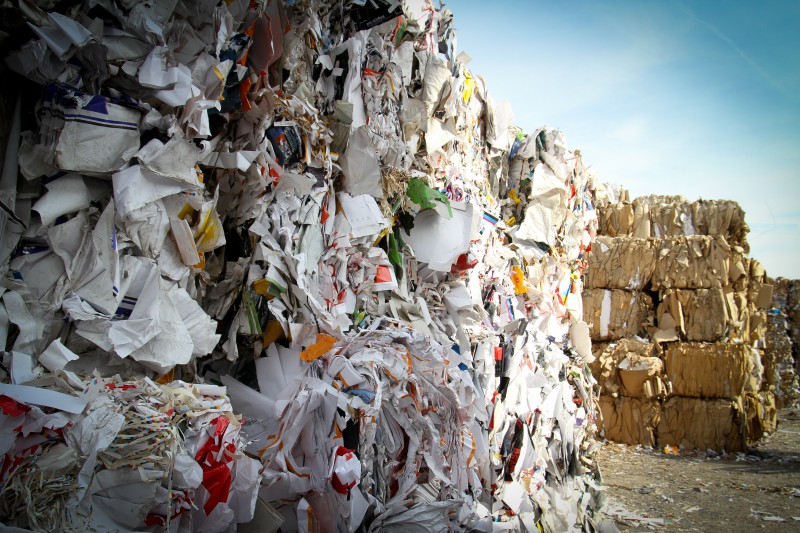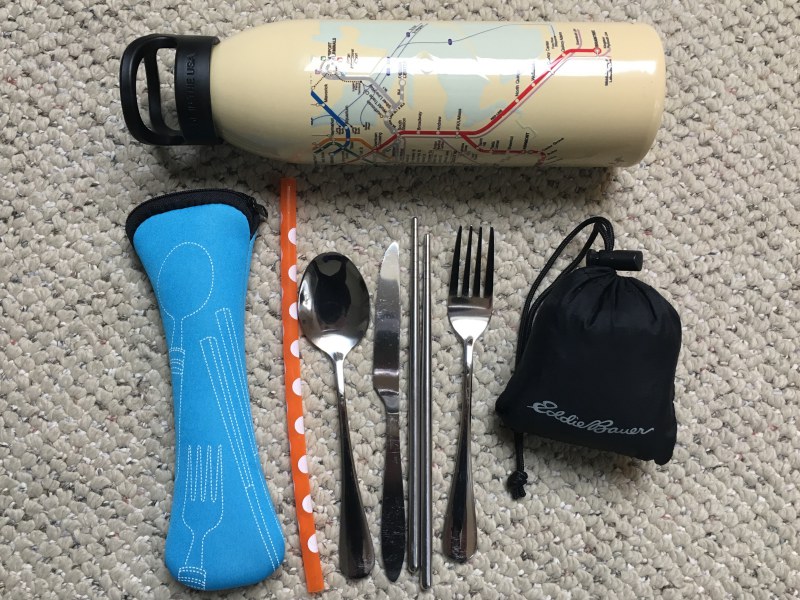6 Ways to Avoid Single-Use Plastic When You Travel
Don’t you just love April? I do, and one reason that I love this month so much (besides being just one month away from my birthday), is that it’s the month the world celebrates our beautiful planet. It’s the perfect time to talk about ways to avoid single-use plastic, right?
Since 1970, Earth Day has been the day designated to celebrate and support environmental protection around the globe.
A day that brings focus to our impact on the environment is a wonderful thing. It (hopefully) encourages you to take action by participating in a local cleanup event (scroll down for help finding an event). Or, perhaps take a look at your lifestyle and decide to make some sustainable changes to lessen the load you put on the planet.
As a traveler and environmentalist, I am ultra conscious of how each trip I take impacts the environment, and whether or not I have any control over it. From the emissions during flights to the amount of trash created, travel is a messy business.
I want to protect the environment but at the same time, I won’t can’t stop traveling. One thing I strive for in everyday life is to avoid the excessive use of single-use plastics. I carry this feat over to my travel life, too.

Unfortunately, plastic is here to stay
Before I share the six ways I avoid single-use plastics when I travel, let’s go over WHY I do it.
Plastic is a durable and long-lasting product, so I understand why it’s one of the most-used man-made products – surpassed only by cement and steel.
Advanced sanitation, human health, and food safety practices all have a surge in plastic production since 1950 to be thankful for. I know I’m thankful to be alive at a time of such high sanitation standards. The bottom line is, life wouldn’t be the way we know it today without the use of plastic.
>> The pragmatic and realistic side to me says, “this is just the way of life in the 21st century.”
As I sit here writing, I can count 13+ plastic items on my desk alone including my laptop, keyboard, mouse, and monitor. Some of the plastic is necessary (i.e. items used for online work), the other handful of items are mostly for my convenience. Plastic pens, a bottle of lotion, speakers – I could probably get through life without these items but I admit, they are incredibly nice to have around.
Although, it is estimated that by 2050 there will be 34 billion tons of plastic on Earth, and almost half of that will be discarded, ending up in landfills or as litter.
>> The idealistic and environmentalist side to me says, “this is fucking ridiculous!”
Let’s just recycle all the plastic then
You might be thinking, “What’s the big deal? Just recycle.” You’re not alone in your thoughts – I also felt the same way for a long time. I’m sorry to say, though, that recycling is NOT the solution.
First of all, it’s not as popular as you may think. Across the globe, only 9% of plastics ever created have been recycled. Europe and China have the highest recycling rates in the world with rates at 30% and 25% respectively. In case you’re wondering, the recycling rate in the United States sits at a low 9%.
Even if there is a rise in recycling rates, it eats up a ton of resources. Think about it. The materials must be collected, sorted, processed, and recreated – all necessary functions that use up fuel, water, electricity, etc. That, in turn, produces waste and byproducts including greenhouse gases and additional trash. It’s an ongoing, vicious cycle.
I do recycle everything I can, but I’m not entirely sure that recycling is actually a better alternative to just discarding plastic due to the additional strain on resources.
*All figures mentioned above are from Ocean Conservancy, condensed from this report by Science Advances.

What is better than recycling?
There is that old saying, Reduce. Reuse. Recycle. See which one comes up last in the lineup?
So, the first step is to reduce the amount of plastic I use. I focus on using fewer single-use plastic items like plastic grocery bags + bottles, to-go containers, plastic forks/spoons, excessive packaging, disposable plastic straws, etc.
Next, I find a way to reuse the plastic items I already have. I reuse many plastics that typically get thrown away after one use such as Ziploc bags, travel-size bottles, and some food containers >> Talenti Gelato FTW!
Then you recycle the leftovers, which ideally isn’t much.
If you’re interested in learning other ways to avoid excessive waste, read the blog Going Zero Waste. There are many other similar blogs out there, but I appreciate her realistic take on plastic and waste in the 21st-century.
How to avoid single-use plastic when you travel
You just have to make the best choice possible in each situation. And make sure you speak up when you see another option available to you. I admit this is something I still struggle with.
Something that helps me in those moments is having something to visualize. Have you heard of the Great Pacific Garbage Patch or seen the video of the poor turtle with a plastic straw stuck in its nose? These images both haunt me and motivate me.
Here’s the video in case you haven’t seen it yet.
Here are six ways to reduce the amount of disposable plastic you use while traveling.
1. Ask for no straw with your drink
Many restaurants will automatically provide a straw when you order a beverage. Remember to say “No straw, please” when you order. Be persistent.
If you have sensitive teeth, ask for no ice. If you still prefer to use a straw when you drink, consider purchasing metal reusable straws (or hard plastic) and carry them with you.
2. Carry a reusable water bottle
Stop buying disposable water bottles when you travel. Whether you choose metal or plastic, get a reusable bottle and carry it with you at all times. Fill it up for free at bubblers (<– those are water fountains for those unfamiliar with Massachusetts lingo), at sinks, or ask a server at a restaurant to fill it up for you.
If you’re inclined, level up to a reusable bottle with an integrated 2-step filtration system. LifeStraw bottles are good for travel to locations with lower drinking water standards than the US, backcountry hiking or camping, or in case of emergencies.
If single-use plastic bottles are absolutely unavoidable, the least you can do is purchase the largest bottles of water possible. Refill your reusable bottle from the larger container.
3. Carry a compact reusable bag
Carry at least one compact reusable bag with you on your travels. Keep it in your purse, daypack, or pocket and use it whenever a clerk or cashier tries to put your new souvenirs or groceries in a plastic bag.
A reusable bag may also come in handy for other uses, as well. Use it to carry dirty clothes to the laundry room at a hostel. Or, stuff it with clothes to create a makeshift pillow while you’re camping or when your hostel pillow is as flat as a pancake.
I use a bag that I bought at Eddie Bauer ages ago and is no longer available. I love it because the strap is long enough to wear the bag cross-body, it’s incredibly compact, and weighs next to nothing. These compact bags by ChicoBag are the closest thing I’ve found to the one I use.

4. Carry real utensils with you
Grab a fork, butter knife, and spoon from your silverware drawer at home and stash them in your daypack or purse. They are all TSA approved for carrying on in your luggage (at the discretion of individual TSA officers, of course).
>> Update: My butterknife was confiscated at the Montreal airport on my way back to the U.S. Sad face.
If you don’t want to pack the good stuff from home, pick up a cheap set at your local thrift store. Alternatively, there are sets you can purchase (or put on your gift wishlist). I recently received this flatware set as a gift, which includes a pair of chopsticks.
However you acquire them, you’ll be ready to decline the offer of plastic utensils when it inevitably comes up.
5. Refill travel-size toiletries bottles
There is no good reason to purchase a new tiny bottle of shampoo every time you take a trip. Refill the small bottles you already have with the product from your large bottles at home.
The small bottles don’t even have to be the same stuff that’s on the label. If it’s drastically different, like you’re putting shampoo into an old conditioner bottle, just take a Sharpie to the bottle and write your own label.
If you happen to not have any old travel-size bottles laying around, get yourself a set of reusable silicone bottles to refill forever. I prefer silicone bottles because the flexible material allows you to squeeze out all the product inside.
6. Don’t get take-out or take home leftovers
To avoid styrofoam and plastic to-go containers when you travel, start by choosing accommodation with a kitchen. Hostels and most Airbnb’s have kitchens, and some hotels have kitchenette suites. This way, you can cook your own meals, which will also help you save money!
If you’re a solo traveler, read the post I wrote on hostel cooking tips.
While eating at restaurants, choose your meals carefully. First, order according to how hungry you actually feel. Choose an appetizer or tapas over an entree, or opt to split an entree when you’re with a travel partner. This reduces food waste in addition to saving plastics from entering the waste stream.
Just do the best you can to avoid single-use plastic
To be 100% honest, it will be a great challenge to stop using single-use plastic when you travel. I struggle during day-to-day life at home and I know many others do as well. The world is set up for our convenience and long travel days or heavy luggage might put a strain on your patience and willingness to sacrifice that convenience.
Some regions in the United States and some countries will challenge your intentions more than others. You just have to do the best you can with the circumstances you can control. Perfection should never be the goal!
As Kathryn from Going Zero Waste says, “Any step in the right direction is a step in the right direction.”
Use these sites to find a cleanup event near you! Or just go out in your neighborhood or your favorite park or beach with a small trash bag and pick up everything you can.
- Like
- X
- Digg
- Del
- Tumblr
- VKontakte
- Buffer
- Love This
- Odnoklassniki
- Meneame
- Blogger
- Amazon
- Yahoo Mail
- Gmail
- AOL
- Newsvine
- HackerNews
- Evernote
- MySpace
- Mail.ru
- Viadeo
- Line
- Comments
- Yummly
- SMS
- Viber
- Telegram
- Subscribe
- Skype
- Facebook Messenger
- Kakao
- LiveJournal
- Yammer
- Edgar
- Fintel
- Mix
- Instapaper
- Copy Link
Thanks for this practical post! I, too, enjoy the Going Zero Waste blog – though it’s a bit less relevant for me as I don’t live in the US, so a lot of the stuff mentioned is harder/impossible to get. In my day-to-day life I’ve already reduced my plastic consumption significantly, but as an avid traveller it has also made me more conscious of the amount of waste – plastic and non-plastic alike – that I generate when I travel. So I think your simple and easy-to-follow tips are great! I already do most of them but am gonna try to remember to bring my own utensils next time!
Hopefully, you’re able to find UK-based alternatives! I’m happy you liked the post. Many of our everyday habits can easily be travel habits, too!